Intel Core i9-13900K and i5-13600K Review: Raptor Lake Brings More Bite
by Gavin Bonshor on October 20, 2022 9:00 AM ESTCPU Benchmark Performance: Power And Office
Our previous sets of ‘office’ benchmarks have often been a mix of science and synthetics, so this time we wanted to keep our office section purely on real-world performance. We've also incorporated our power testing into this section too.
The biggest update to our Office-focused tests for 2023 and beyond include UL's Procyon software, which is the successor to PCMark. Procyon benchmarks office performance using Microsoft Office applications, as well as Adobe's Photoshop/Lightroom photo editing software, and Adobe Premier Pro's video editing capabilities. Due to issues with UL Procyon and the video editing test, we haven't been able to properly run these, but once we identify a fix with UL, we will re-test each chip.
We are using DDR5 memory on the Core i9-13900K, the Core i5-13600K, the Ryzen 9 7950X, and Ryzen 5 7600X, as well as Intel's 12th Gen (Alder Lake) processors at the following settings:
- DDR5-5600B CL46 - Intel 13th Gen
- DDR5-5200 CL44 - Ryzen 7000
- DDR5-4800 (B) CL40 - Intel 12th Gen
All other CPUs such as Ryzen 5000 and 3000 were tested at the relevant JEDEC settings as per the processor's individual memory support with DDR4.
Power
The nature of reporting processor power consumption has become, in part, a bit of a nightmare. Historically the peak power consumption of a processor, as purchased, is given by its Thermal Design Power (TDP, or PL1). For many markets, such as embedded processors, that value of TDP still signifies the peak power consumption. For the processors we test at AnandTech, either desktop, notebook, or enterprise, this is not always the case.
Modern high-performance processors implement a feature called Turbo. This allows, usually for a limited time, a processor to go beyond its rated frequency. Exactly how far the processor goes depends on a few factors, such as the Turbo Power Limit (PL2), whether the peak frequency is hard coded, the thermals, and the power delivery. Turbo can sometimes be very aggressive, allowing power values 2.5x above the rated TDP.
AMD and Intel have different definitions for TDP that are, broadly speaking, applied the same. The difference comes from turbo modes, turbo limits, turbo budgets, and how the processors manage that power balance. These topics are 10000-12000 word articles in their own right, and we’ve got a few articles worth reading on the topic.
- Why Intel Processors Draw More Power Than Expected: TDP and Turbo Explained
- Talking TDP, Turbo and Overclocking: An Interview with Intel Fellow Guy Therien
- Reaching for Turbo: Aligning Perception with AMD’s Frequency Metrics
- Intel’s TDP Shenanigans Hurts Everyone
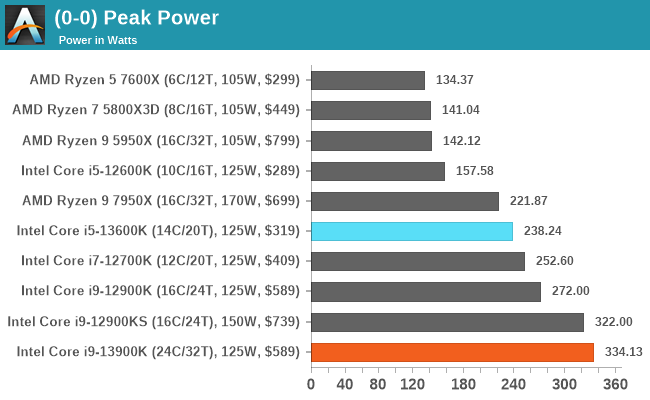
Directly digesting the peak power figures from both the Core i5-13600K and Core i9-13900K processors, the latter drew around 12 W more than the Core i9-12900KS does, and 62 W more than the regular Core i9-12900K. While additional power draw was to be expected due to the very high core clock speeds, let's not forget it is also a 24-core processor, hybrid cores or not.
Even so, the Core i9-13900K drew 32% more power than its 253 W Turbo PL2 limit, but it's very unlikely most users that are gaming or doing general PC stuff will ever see power figures like this. The key to note really with the Core i9-13900K is if it is using this power (125 W TDP to 253 W TDP = 2.02x the power) efficiently for the benefit of performance, then it makes it a less harsh pill to swallow. We would certainly recommend premium cooling with this for maximum performance efficiency.
Looking at the Core i5-13600K, this sits a bit higher than the AMD Ryzen 7950X in terms of peak power consumption, and just below the Core i7-12700K. The Core i5-13600K does draw considerably more power than its predecessor, the Core i5-12600K (157 W versus 238 W), but the increase in both core frequency and double the E-cores, is to be expected.
Looking deeper into the high power consumption of the Core i9-13900K, we can see that it is shooting above Intel's PL2 value considerably more than the previous generation. One potential reason for this is down to motherboard vendors continuing to ignore PL2 limits and optimizing for performance under a thermal limit as opposed to power.
During our testing of the AMD Ryzen 9 7950X, we saw our GIGABYTE X670E Aorus Master AM5 motherboard adhere to AMD’s PPT limit, yet with our MSI MPG Z790 Carbon WIFI, we are overshooting the 253 W PL1 limit by around 40-42% at peak figures. While we don’t believe that Intel is ignoring its own classification and specification of power limits here, we believe that the onus is on motherboard vendors to adhere to these limits. A lot of the time, motherboard manufacturers want to deliver the best possible performance out of the box it can, and while we don’t necessarily believe this is a massive negative, it does paint a picture that the Core i9-13900K has insane power draw at maximum load. A power draw that would otherwise be tempered significantly by adhering to PL2.
As we do some additional testing with the MSI MPG Z790 Carbon WIFI, we'll see if this is a specific problem with this particular motherboard, or if it’s the Z790 platform itself. We’ll also look to test some other LGA1700 models we have available, and we’ll update this analysis with our findings.
Office/Web
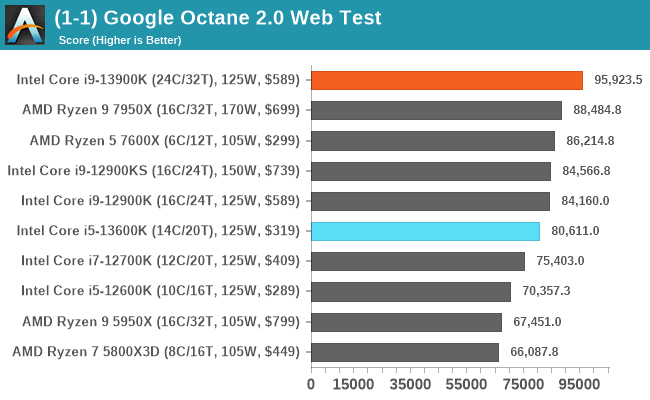
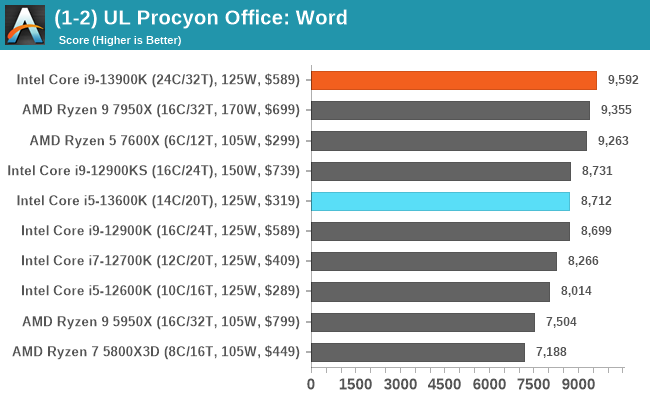
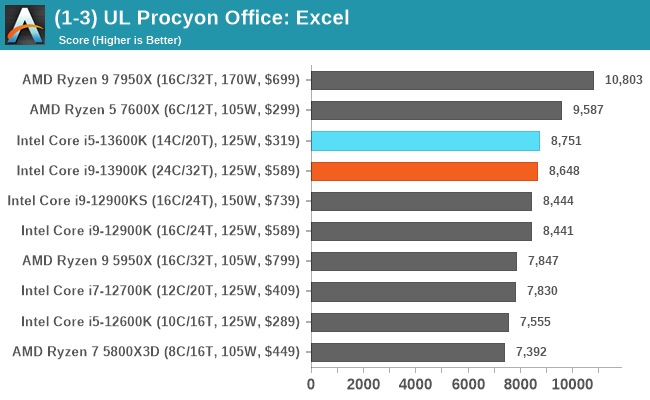
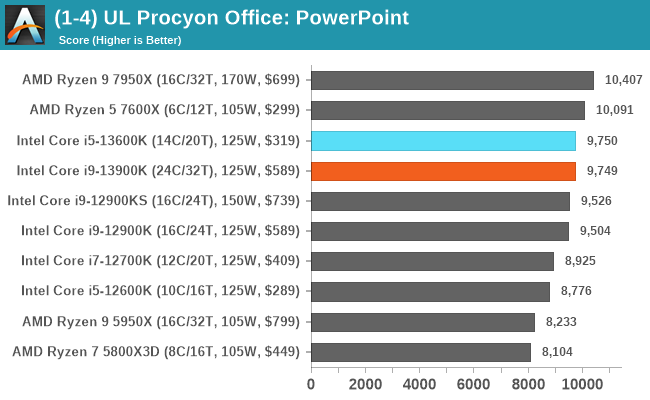

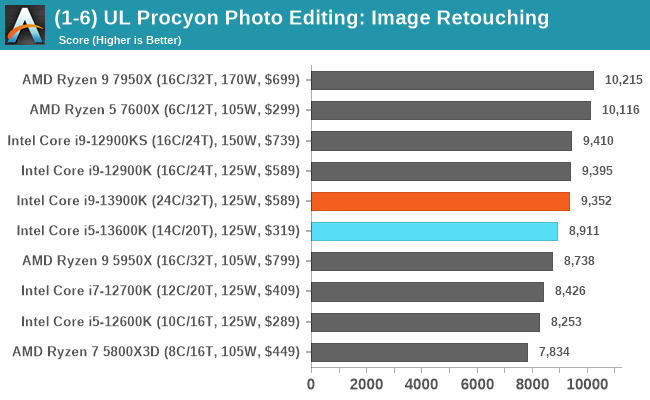
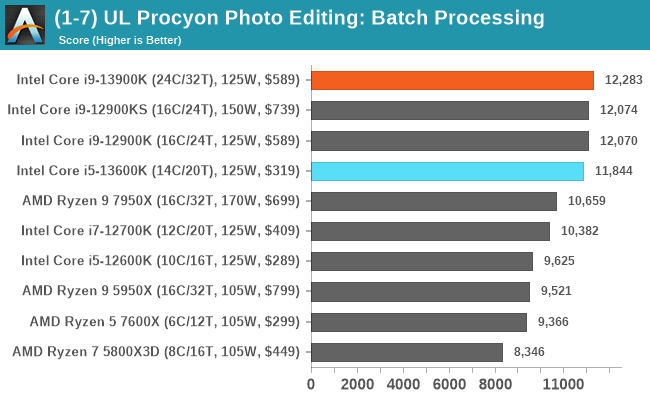
Looking at real-world web and office performance, the Core i9-13900K performs very well, and in a lot of tests, is neck and neck with the Ryzen 9 7950X. This is interesting given the Zen 4 is a new core on a new 5 nm process, and the Intel 13th Gen Core is a refined Intel 7 (10 nm) solution. The Core i5-13600K also performs competitively, and even the previous generation Core i9-12900KS are also in the thick of things.


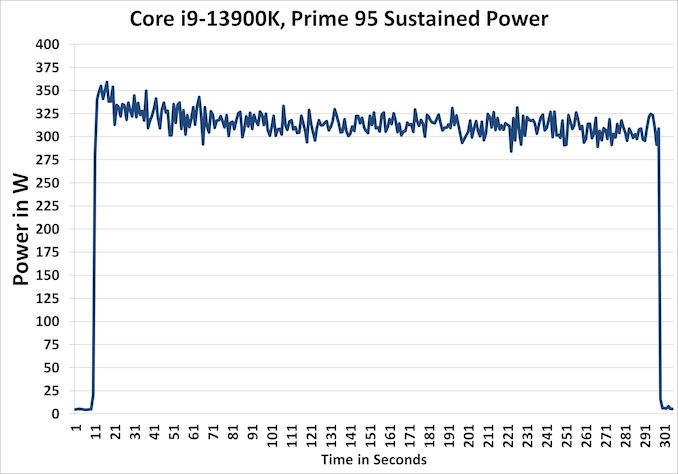








169 Comments
View All Comments
adenta180 - Friday, June 23, 2023 - link
Did you guys ever get to the bottom of this SPECint rate GCC regression on 13900K? ReplyAvalon - Friday, October 21, 2022 - link
I think it's starting to become a little disingenuous to list the default TDP in the benchmarks, when it's become increasingly obvious over the past few generations that Intel chips run nowhere in the stratosphere of those TDPs.When you see a "125W" $589 chip virtually tied with a "170W" $699 chip it makes it seem like Intel is a no brainer. Might be time to start putting actual power draw in each of the tests in there, or simply leave stock TDP out, because listing a Core i9 at "125W" when it's running 50-100W higher than an equivalent AMD chip doesn't make much sense any longer. Reply
WannaBeOCer - Friday, October 21, 2022 - link
Did you even read the article? Intel advertises the 13900k as a 253w chip. It drew 32% more than it advertised while AMD advertises its 7950x as a 170w and it drew 30% more than they advertised. On all of Intel’s slides“Processor Base Power
125 W
Maximum Turbo Power
253 W” Reply
bcortens - Saturday, October 22, 2022 - link
Doesn’t matter if they advertise it. The charts are misleading because the W number at the left of the chart has nothing to do with the power consumed to get the performance indicated in the chart.They should really just leave the W number off or show a measured average W required to complete the test. Then the number would have meaning. As it stands, for the purposes of the graph, the number doesn’t mean much. Reply
Avalon - Friday, October 21, 2022 - link
And, to be fair to Intel, why are some of the IGP gaming benchmarks only showing the 12th and 13th gen Intel vs AMD APUs? There's really nothing to be gleaned from this; of course APUs will be faster in IGP tests. If you can't do like for like, then either just publish the Intel scores or don't publish at all. ReplyIketh - Friday, October 21, 2022 - link
In your closing comments about power consumption, I was reminded about the AMD article that compared the performance difference between 230W and 65W. I think you should also mention that in this article. I'm holding out for AMD mobile parts. Those laptops will be nice. ReplyIketh - Friday, October 21, 2022 - link
125W on Intel 7 process, when it's actually 325W on 10nm lmao... pure marketing ReplyWannaBeOCer - Friday, October 21, 2022 - link
Did you even read the article? Intel advertises the 13900k as a 253w chip. It drew 32% more than it advertised while AMD advertises its 7950x as a 170w and it drew 30% more than they advertised. On all of Intel’s slides“Processor Base Power
125 W
Maximum Turbo Power
253 W” Reply
bcortens - Saturday, October 22, 2022 - link
Reviews shouldn’t care about the advertised power, or what it says in the bios when you set the “limit” to 65 watts, reviews should actually measure and report the real power draw.We don’t read reviews to read intel and amd marketing numbers, we want to know the real numbers for a given workload Reply
Iketh - Sunday, October 23, 2022 - link
what on earth does that have to do with my statement Reply